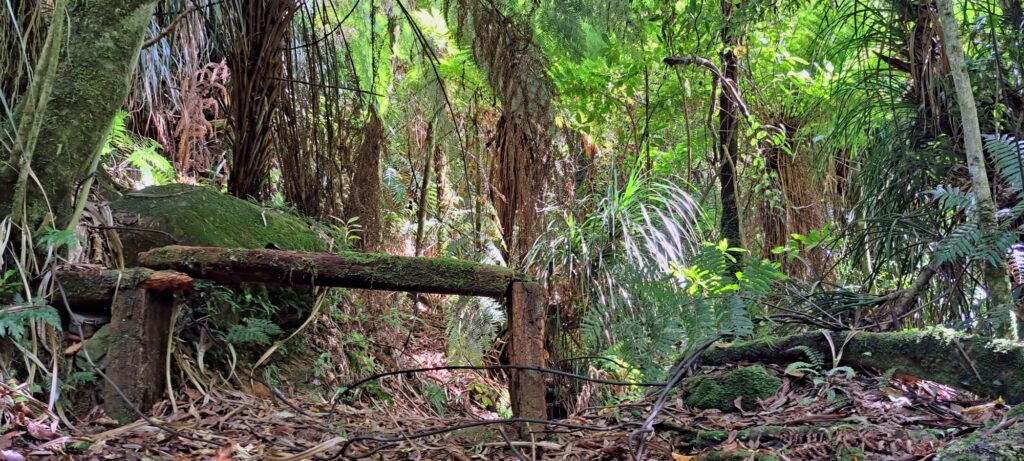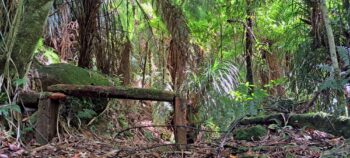The Secret Tracks of Wainuiomata: Historic Trails Beyond the Map
Wainuiomata is renowned for its numerous bush walks, but there are also several unofficial trails that, though challenging, can still be explored. These paths include historic routes that are now overgrown or poorly maintained, and some older versions of existing tracks that were relocated. There are also tracks that once existed, but with no trace left today, they leave stories of historical importance.
Some of these old and overgrown tracks date back to the forestry days of the 1850s to 1860s when Wainuiomata was logged. While some of these tracks continued as firebreaks, others were completely abandoned and forgotten. Further, newer and more efficient tracks have made several older ones redundant while other tracks have been redirected due to their original locations within or near the old water catchment zone perimeter.
Decades ago, the Water Board restricted access to the water catchment and surrounding area to prevent potential water contamination, resulting in some tracks being rerouted. In many cases, the older tracks make for useful shortcuts to official tracks. They remain navigable because they are still walked, which helps to maintain them, or because they are used as baiting tracks and receive some official upkeep.
Walking these tracks can be challenging, and the lack of signage makes it easy to get lost. Only experienced trampers should attempt these trails and sometimes you need to do some bush bashing in sections that have completely overgrown. Further, it’s always wise to inform others of your plans before setting out. Fortunately, some of these tracks have phone reception, particularly on ridges or high mountain slopes. This offers the opportunity to update someone of your location and intended route if you decide to change course or just give an update to where you are.
These walks are labeled unofficial, meaning they are not maintained by the Greater Wellington Regional Council (GWRC). Many of these tracks do not appear on maps, and if they do, they are often unnamed. While they are known to some locals, they often refer to them by different names.
Bivy Track
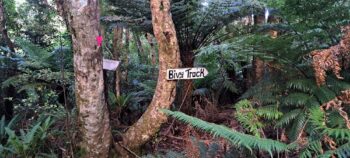 Bivy Track provides a link between Scholes Creek Track at Camp Wainui along the Coast Road to the Crowther Ridge Track above or vice versa. At the bottom of the track is a bivy that can be used as emergency accommodation.
Bivy Track provides a link between Scholes Creek Track at Camp Wainui along the Coast Road to the Crowther Ridge Track above or vice versa. At the bottom of the track is a bivy that can be used as emergency accommodation.
ECNZ Power Pylon Road / Track
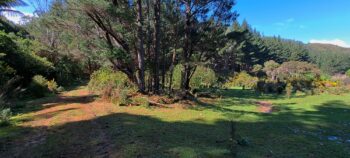 The ECNZ Power Pylon Road, built in the 1950s–60s by the Electricity Corporation of New Zealand, provided access to power pylons along the ridge between the Hutt Valley and Wainuiomata. It runs from Seaview, over Wainuiomata Hill via Pukeatua Bridge, and through Moores Valley into Whitemans Valley.
The ECNZ Power Pylon Road, built in the 1950s–60s by the Electricity Corporation of New Zealand, provided access to power pylons along the ridge between the Hutt Valley and Wainuiomata. It runs from Seaview, over Wainuiomata Hill via Pukeatua Bridge, and through Moores Valley into Whitemans Valley.
Gawler Reservoir Track
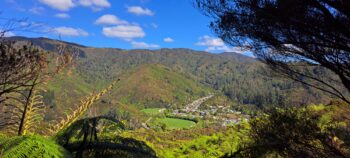 The Gawler Reservoir Track extends past the reservoir, leading up to the ridgeline with impressive views over Sunny Grove and nearby areas. This elevated section offers a rewarding perspective on the Wainuiomata Scenic Reserve’s landscape,
The Gawler Reservoir Track extends past the reservoir, leading up to the ridgeline with impressive views over Sunny Grove and nearby areas. This elevated section offers a rewarding perspective on the Wainuiomata Scenic Reserve’s landscape,
Hine Road Track
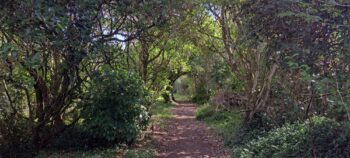 The Hine Road Track in Wainuiomata is a short, flat trail that follows the Wainuiomata River behind the houses on Hine Road. It connects Richard Prouse Park to the Hine Road Recreation Area, providing a convenient link between these reserves.
The Hine Road Track in Wainuiomata is a short, flat trail that follows the Wainuiomata River behind the houses on Hine Road. It connects Richard Prouse Park to the Hine Road Recreation Area, providing a convenient link between these reserves.
Maintenance Track
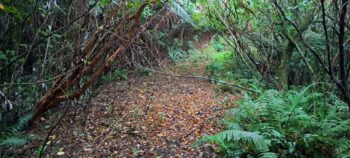 Maintenance Track, once part of Maintenance Road, runs parallel to Reservoir Road. Though it is overgrown today, adventurous types can still navigate through the dense vegetation along this section.
Maintenance Track, once part of Maintenance Road, runs parallel to Reservoir Road. Though it is overgrown today, adventurous types can still navigate through the dense vegetation along this section.
McKerrow Ridge Track
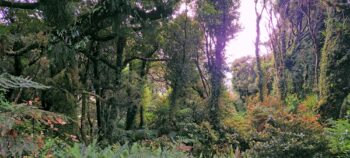 Mckerrow Ridge Track (Old McKerrow Track) is an earlier segment of the McKerrow Track, now superseded. Although it’s no longer an official track, the old section still receives some maintenance and can still be walked.
Mckerrow Ridge Track (Old McKerrow Track) is an earlier segment of the McKerrow Track, now superseded. Although it’s no longer an official track, the old section still receives some maintenance and can still be walked.
Mill to Moness Track
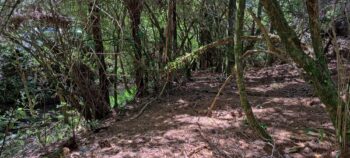 This track isn’t particularly worth exploring since only a small section of it remains. However, its history is intriguing because of its time period and route. The track connected to the Moness homestead and likely led to the Sinclair family’s sawmill. The Sinclairs were early loggers in the area, adding historical significance to the track’s existence.
This track isn’t particularly worth exploring since only a small section of it remains. However, its history is intriguing because of its time period and route. The track connected to the Moness homestead and likely led to the Sinclair family’s sawmill. The Sinclairs were early loggers in the area, adding historical significance to the track’s existence.
Mount Crowther Track
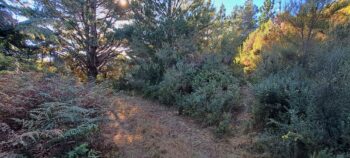 The Mount Crowther Track meanders through the Harry Todd Recreation Reserve in Wainuiomata. Serving as a firebreak, it features a wide path with sections that are steep, making parts of the walk relatively easy while the steeper areas present a challenge. The track also links to other, less maintained tracks in the surrounding bush.
The Mount Crowther Track meanders through the Harry Todd Recreation Reserve in Wainuiomata. Serving as a firebreak, it features a wide path with sections that are steep, making parts of the walk relatively easy while the steeper areas present a challenge. The track also links to other, less maintained tracks in the surrounding bush.
Old Nikau Creek Track
The entrance to the latter part of the Old Nikau Creek Track lies hidden behind the sign that marks the end of the current Nikau Creek Track. The current track covers much of the initial section of the old track. This hidden latter part of the track concludes near an old wooden bench at the back of Nikau Creek Valley. The track’s origin is unclear, though it probably began as a forestry track. An old wooden bench seat can be found near the track’s end and the seat looks quite old.
Old Whakanui Track
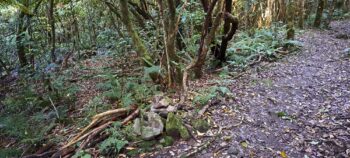 The former Whakanui Track originally began as a Māori trail. Today, it partially coincides with the Nikau Creek Track but then diverges, climbing up the ridge behind Nikau Creek Valley. It eventually joins the Whakanui Track, continuing on to the Orongorongo Valley.
The former Whakanui Track originally began as a Māori trail. Today, it partially coincides with the Nikau Creek Track but then diverges, climbing up the ridge behind Nikau Creek Valley. It eventually joins the Whakanui Track, continuing on to the Orongorongo Valley.
Scholes Creek Track
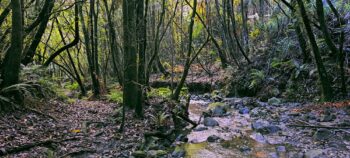 The Scholes Creek Track starts at Camp Wainui on Coast Road and leads to a 5-meter waterfall. Close to the start, there’s a connection to Bivy Track, which ascends to McKerrow Ridge Track.
The Scholes Creek Track starts at Camp Wainui on Coast Road and leads to a 5-meter waterfall. Close to the start, there’s a connection to Bivy Track, which ascends to McKerrow Ridge Track.
Sinclair Track
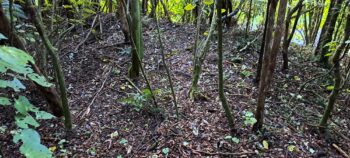 Sinclair Track is a historic forestry route dating back to the 1870s. While it remains mostly inaccessible today due to being overtaken by the bush. The track can still be followed in sections with the aid of cuttings in the banks, which suggest it may once have served as a main trunk line for a wooden railway used to transport logs to a nearby mill.
Sinclair Track is a historic forestry route dating back to the 1870s. While it remains mostly inaccessible today due to being overtaken by the bush. The track can still be followed in sections with the aid of cuttings in the banks, which suggest it may once have served as a main trunk line for a wooden railway used to transport logs to a nearby mill.
Spear Cut Track
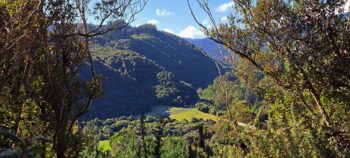 Spear Cut Track was a former firebreak and could even have been an old forestry track that existed during the 1850s when the hill was logged. The track starts at the top of Willis Grove and goes to Mt Crowther Trig.
Spear Cut Track was a former firebreak and could even have been an old forestry track that existed during the 1850s when the hill was logged. The track starts at the top of Willis Grove and goes to Mt Crowther Trig.
Sunny Grove Track
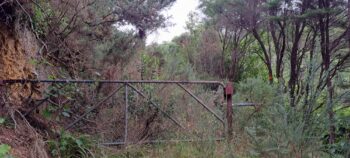 The Sunny Grove Track was originally the starting point of the Whakanui Track. The current starting point for the Whakanui Track is now located above Sunny Grove, but the older starting point remains conveniently accessible near the Hine Road Recreation Area, where a car park is available. This older track links to the new track.
The Sunny Grove Track was originally the starting point of the Whakanui Track. The current starting point for the Whakanui Track is now located above Sunny Grove, but the older starting point remains conveniently accessible near the Hine Road Recreation Area, where a car park is available. This older track links to the new track.
Water Race Track
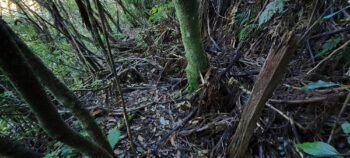 The Water Race Track was a narrow, largely level path cut into the steep slope of Reservoir Valley, providing access to the covered water race that conveyed water from the old reservoir to Coleman’s Tunnel. It was used throughout both the construction and ongoing maintenance of the race, enabling workers to inspect and service the water supply infrastructure along the hillside.
The Water Race Track was a narrow, largely level path cut into the steep slope of Reservoir Valley, providing access to the covered water race that conveyed water from the old reservoir to Coleman’s Tunnel. It was used throughout both the construction and ongoing maintenance of the race, enabling workers to inspect and service the water supply infrastructure along the hillside.
Wainuiomata River Track
This track began in what is now the Homedale/Village area of Wainuiomata and followed the west side of the Wainuiomata River. Consequently, houses such as Willowbank (Burdans), Hermitage (Graces), and Richard Prouse’s home were built on this side of the river in the 1850s. This was because it was believed the future road would follow the track along the west side of the Wainuiomata River valley. However, in the 1860s and later, the road was developed along the east side of the river instead. There may or may not be remnants of this track left, but if there is, it would be on private land which is mostly pasture.

